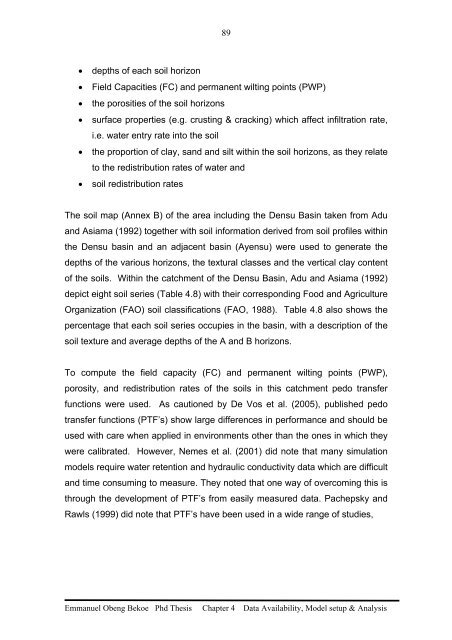PhD Thesis Emmanuel Obeng Bekoe - Cranfield University
PhD Thesis Emmanuel Obeng Bekoe - Cranfield University
PhD Thesis Emmanuel Obeng Bekoe - Cranfield University
Create successful ePaper yourself
Turn your PDF publications into a flip-book with our unique Google optimized e-Paper software.
• depths of each soil horizon<br />
• Field Capacities (FC) and permanent wilting points (PWP)<br />
• the porosities of the soil horizons<br />
89<br />
• surface properties (e.g. crusting & cracking) which affect infiltration rate,<br />
i.e. water entry rate into the soil<br />
• the proportion of clay, sand and silt within the soil horizons, as they relate<br />
to the redistribution rates of water and<br />
• soil redistribution rates<br />
The soil map (Annex B) of the area including the Densu Basin taken from Adu<br />
and Asiama (1992) together with soil information derived from soil profiles within<br />
the Densu basin and an adjacent basin (Ayensu) were used to generate the<br />
depths of the various horizons, the textural classes and the vertical clay content<br />
of the soils. Within the catchment of the Densu Basin, Adu and Asiama (1992)<br />
depict eight soil series (Table 4.8) with their corresponding Food and Agriculture<br />
Organization (FAO) soil classifications (FAO, 1988). Table 4.8 also shows the<br />
percentage that each soil series occupies in the basin, with a description of the<br />
soil texture and average depths of the A and B horizons.<br />
To compute the field capacity (FC) and permanent wilting points (PWP),<br />
porosity, and redistribution rates of the soils in this catchment pedo transfer<br />
functions were used. As cautioned by De Vos et al. (2005), published pedo<br />
transfer functions (PTF’s) show large differences in performance and should be<br />
used with care when applied in environments other than the ones in which they<br />
were calibrated. However, Nemes et al. (2001) did note that many simulation<br />
models require water retention and hydraulic conductivity data which are difficult<br />
and time consuming to measure. They noted that one way of overcoming this is<br />
through the development of PTF’s from easily measured data. Pachepsky and<br />
Rawls (1999) did note that PTF’s have been used in a wide range of studies,<br />
<strong>Emmanuel</strong> <strong>Obeng</strong> <strong>Bekoe</strong> Phd <strong>Thesis</strong> Chapter 4 Data Availability, Model setup & Analysis

















